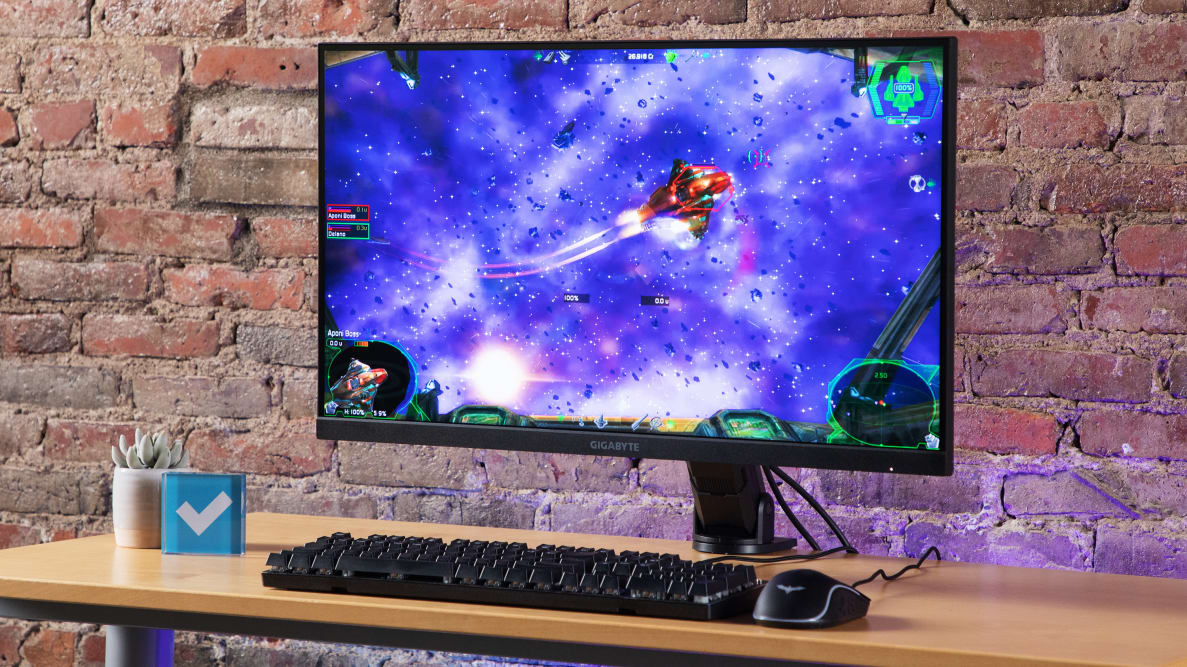Pros
-
Sharp visuals
-
Exceptional color presentation
-
Handy hub features
Cons
-
Basic HDR
-
Underperforms 1440p monitors and 4K TVs
It’s a strong option with solid features and modest performance that make it a good all-around gaming centerpiece for PC and consoles alike, but not necessarily the right pick for everyone.
About the Gigabyte M28U
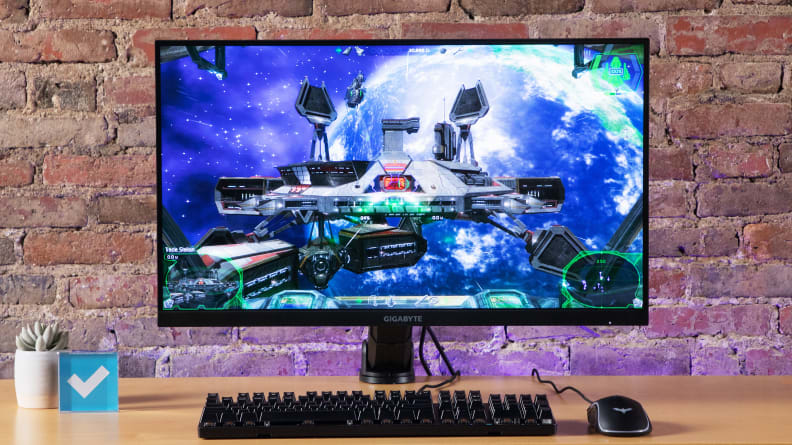
The Gigabyte M28U's 28-inch panel 4K resolution provides exceedingly crisp visuals thanks to the 157 pixels-per-inch density.
Here are the specs of the monitor we tested:
- Price: $500
- Display size: 28 inches
- Resolution: 3840 x 2160 pixels
- Refresh rate: 144Hz
- Peak brightness: 300 nits (SDR rated), 286.2 nits (tested), 453 nits (with HDR + Local dimming)
- HDR support: VESA DisplayHDR 400
- Color depth: 8-bit
- Color saturation: 94% DCI-P3, 120% sRGB (rated); 90% DCI-P3 (tested), 100% sRGB (tested)
- Contrast ratio: 1,000:1 (rated); 910:1 (tested)
- Pixel response time (GtG): 1ms
- Ports: 2x HDMI 2.1, 1 x DisplayPort 1.4 (DSC), 1 x USB 3.2 Gen 1 (upstream), 1 x USB-C (upstream, DP Alt Mode, 18W PD), 1 x USB 3.0 upstream, 3 x USB 3.2 Gen 1 (downstream), 1 x 3.5mm
- VRR Support: FreeSync Premium Pro
- Other features: VESA mount (100x100), integrated KVM switch, x2 3-watt stereo speakers
The Gigabyte M28U comes in two styles. One features a more typical adjustable stand like that seen on many Gigabyte monitors in the last couple of years, and another that uses an adjustable monitor arm that clamps to the desk. Pricing of the two monitors is the same, but discounts can affect one and not the other, leading to occasional disparities. Gigabyte also offers a 32-inch version, the M32U, that’s largely similar, but may not have equivalent performance because of the different display panel used.
What we like
The rich, accurate color
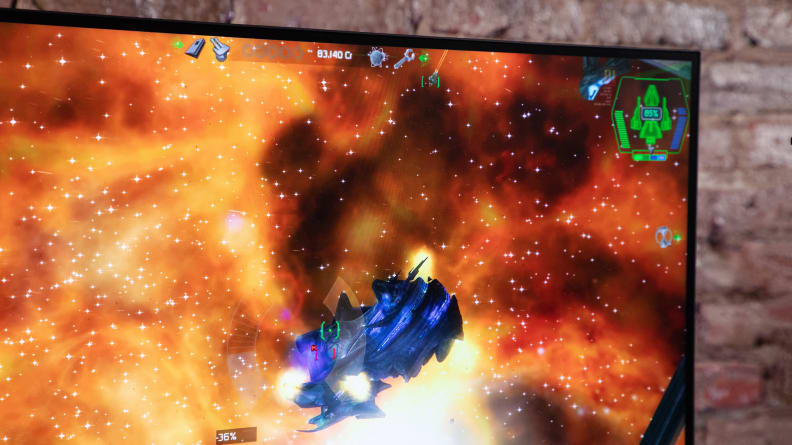
The Gigabyte M28U managed an impressive average color dE less than 1, which effectively means you won’t be able to perceive any color errors.
Picking up a 4K monitor is rarely just about getting some eight million odd pixels. There’s an expectation of a higher level of quality when making the jump, and a large part of that comes from color. The Gigabyte M28U offers a lot of color, too.
In testing, it managed to completely cover the sRGB color space and hit 90% coverage of the popular DCI-P3 color space that’s being used more and more in media content. This provides the monitor with a rich palette that lends game and movie scenes alike a more lifelike and engaging picture.
A big perk for content creators is that the color accuracy is spot on out of the box. The Gigabyte M28U managed an impressive average color dE less than 1, which effectively means you won’t be able to perceive any color errors. Further still, not a single color in our test had a dE over 3, which is the point at which an error might be detected by the naked eye.
The low price point for 4K gaming
A quick look at our best 4K monitors shows that few quality options are delivering that high resolution alongside the fast refresh rate required for smooth video game visuals. Those that do offer both 4K and a refresh rate over 120Hz tend to cost closer to $1,000. That the Gigabyte M28U comes in at nearly half that is no small feat.
On its 28-inch panel, the M28U’s 4K resolution provides exceedingly crisp visuals thanks to the 157 pixels-per-inch density. That’s enough to show fine detail in everything from video game character designs to small text while browsing, with the added benefit of removing jagged edges.
Sometimes cheaper monitors, even IPS panels that offer a fast refresh rate, can struggle with slow pixel response times that don’t keep up with the action, leading to smeared trails behind moving elements on the screen. That’s something I saw with Gigabyte’s M32U. Impressively, that’s largely absent on the M28U, allowing it to deliver a strong combination of 4K and 144Hz without much compromise.
The multiple roles it can play on a desk
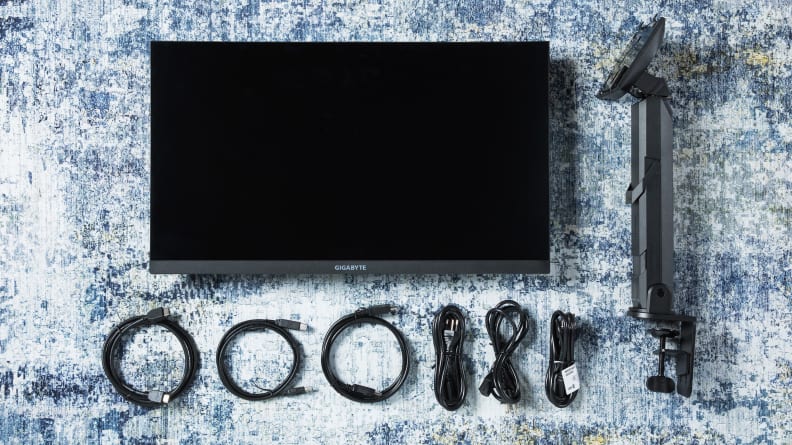
Gigabyte has earned props in the gaming monitor market thanks to the strong value of its Gigabyte G24F 2.
Lower-cost monitors often skimp out on ports, limiting their ability to easily support multiple devices in a single setup. That’s not the case with the Gigabyte M28U. It has a pair of HDMI 2.1 ports that’ll happily accept a 4K/120Hz signal coming in from a PlayStation 5 or Xbox Series X, and it even worked with a PC at 4K/144Hz. DisplayPort 1.4 with Display Stream Compression also supports the full resolution and refresh rate.
Topping it off, the monitor includes a USB-C port to connect with laptops or other devices and receives a DisplayPort 1.4 video signal. That port only delivers 18 watts, so don’t expect it to keep higher-power laptops charged.
Gigabyte goes further still with the included USB hub. There are three USB-A ports for connecting peripherals. Those ports can link up with the device connected via USB-C or a separate device using a separate USB-B port, and there’s a KVM switch built in to toggle between the two.
All of this serves to make the Gigabyte M28U a competent centerpiece for entertainment. And it still has more to offer thanks to a set of speakers that are perfectly competent for everyday listening. They can’t get close to the best PC speakers, but they’ll serve in a pinch when you feel like giving your ears a break from a gaming headset.
What we don’t like
The limited HDR capabilities
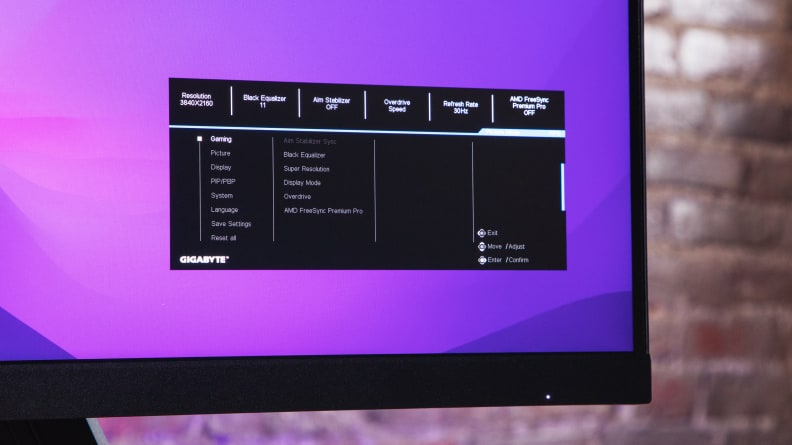
The Gigbyte M28U is VESA mount (100x100) compatible and has an integrated KVM switch, x2 3-watt stereo speakers, and more.
Though the Gigabyte M28U’s color performance is impressive, there’s nothing to get excited about when it comes to HDR. The display will accept an HDR signal and provide pleasing colors in turn, but when it comes to brilliant highlights and rich contrast, it comes up lacking.
In a best-case scenario, I was able to get a 1,000:1 contrast ratio. That’s about where any IPS monitor will perform, so there’s nothing special here. At that point, the peak brightness was only hitting 300 nits as well. Turning on the display’s local dimming feature, which is a basic edge-lit implementation, the contrast measure actually got worse, though I saw highlights reach about 453 nits.
While it can be hard to get great HDR performance at around this price, it’s not impossible. The budget Acer Nitro XV272U, as well as the Gigabyte M27Q X both performed better, and they’re both several hundred dollars cheaper thanks to their 1440p panels.
Should you buy it?
Maybe, if sharpness is your priority
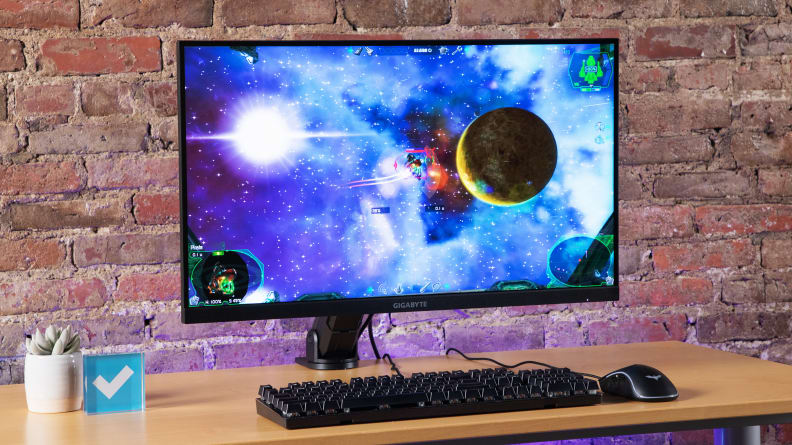
The Gigabyte M28U comes in two styles, one features a more typical adjustable stand like that seen on many Gigabyte monitors in the last couple of years and another that uses an adjustable monitor arm.
The Gigabyte M28U has a few strengths that blend nicely together. Its color accuracy and range, 4K clarity, and smooth motion make for an enjoyable picture for most types of content. Competitive shooters are responsive. RTS games will display fine details for all the small units that can fill the map. And all media types just look good on the panel.
If that mixture of ingredients sounds right for your tastes, then there’s little reason to shy away from the M28U. But there are some good alternatives if your priorities aren’t perfectly lined up with what Gigabyte is offering here.
If your reason for considering the M28U is just because you want the best looking 4K picture you can get for your money, then you’ll want to look elsewhere. If you’ve got the room to use a medium-sized TV instead, that market is leagues ahead in HDR performance and has stepped up in gaming as well. The 55-inch Hisense U8H destroys the Gigabyte M28U when it comes to picture quality with brilliant HDR, wide color gamut, and even offers a 4K/120Hz mode for gamers. It’s often only $649. Of course, for many, going for a TV instead of a monitor won’t always make sense. These TVs take up a lot more space and use more power. You also not only need more desk space but also will want to be able to sit further back from the screen while playing, which may not always be possible.
Meanwhile, if you don’t mind a lower resolution—1440p still looks plenty crisp on displays of this size—you can get a monitor that’s better in most other regards. Gigabyte’s own M27Q X can be found for cheaper on sale, has better contrast, wider gamut, more accurate color, brighter HDR highlights, similar quality-of-life features, and can zip along at 240Hz for even smoother gameplay. The new M27U, meanwhile, is slightly smaller than the M28U but goes up to 160Hz and hits HDR600. The 1440p HP X27q isn’t quite as impressive, but similarly does a good job keeping pace with the M28U in most regards, and it only costs about $200.
Meet the tester

Mark Knapp
Contributor
Mark Knapp has covered tech for most of the past decade, keeping readers up to speed on the latest developments and going hands-on with everything from phones and computers to e-bikes and drones to separate the marketing from the reality. Catch him on Twitter at @Techn0Mark or on Reviewed, IGN, TechRadar, T3, PCMag, and Business Insider.
Checking our work.
Our team is here to help you buy the best stuff and love what you own. Our writers, editors, and experts obsess over the products we cover to make sure you're confident and satisfied. Have a different opinion about something we recommend? Email us and we'll compare notes.
Shoot us an email
